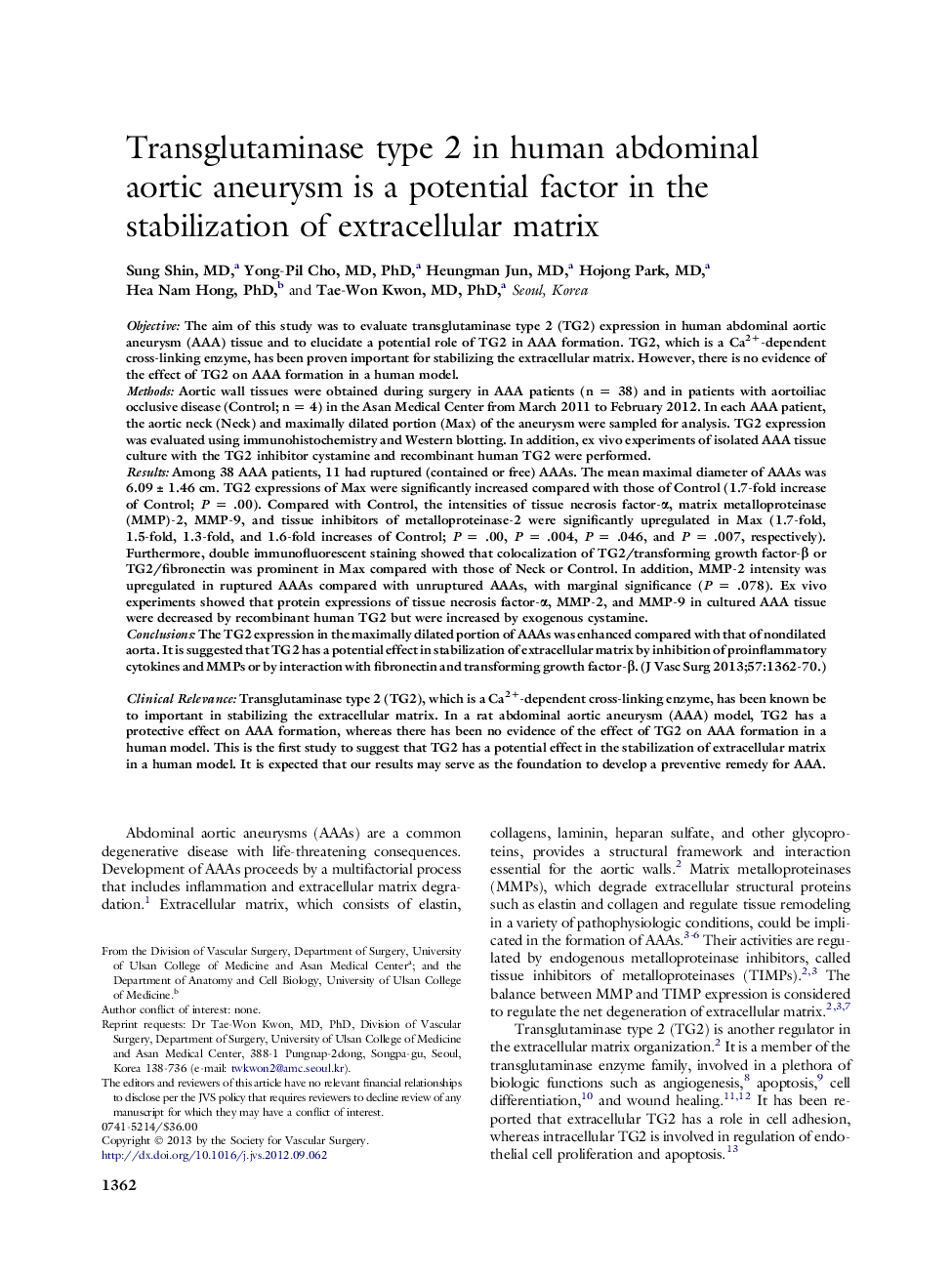| کد مقاله | کد نشریه | سال انتشار | مقاله انگلیسی | نسخه تمام متن |
|---|---|---|---|---|
| 2991247 | 1179864 | 2013 | 9 صفحه PDF | دانلود رایگان |

ObjectiveThe aim of this study was to evaluate transglutaminase type 2 (TG2) expression in human abdominal aortic aneurysm (AAA) tissue and to elucidate a potential role of TG2 in AAA formation. TG2, which is a Ca2+-dependent cross-linking enzyme, has been proven important for stabilizing the extracellular matrix. However, there is no evidence of the effect of TG2 on AAA formation in a human model.MethodsAortic wall tissues were obtained during surgery in AAA patients (n = 38) and in patients with aortoiliac occlusive disease (Control; n = 4) in the Asan Medical Center from March 2011 to February 2012. In each AAA patient, the aortic neck (Neck) and maximally dilated portion (Max) of the aneurysm were sampled for analysis. TG2 expression was evaluated using immunohistochemistry and Western blotting. In addition, ex vivo experiments of isolated AAA tissue culture with the TG2 inhibitor cystamine and recombinant human TG2 were performed.ResultsAmong 38 AAA patients, 11 had ruptured (contained or free) AAAs. The mean maximal diameter of AAAs was 6.09 ± 1.46 cm. TG2 expressions of Max were significantly increased compared with those of Control (1.7-fold increase of Control; P = .00). Compared with Control, the intensities of tissue necrosis factor-α, matrix metalloproteinase (MMP)-2, MMP-9, and tissue inhibitors of metalloproteinase-2 were significantly upregulated in Max (1.7-fold, 1.5-fold, 1.3-fold, and 1.6-fold increases of Control; P = .00, P = .004, P = .046, and P = .007, respectively). Furthermore, double immunofluorescent staining showed that colocalization of TG2/transforming growth factor-β or TG2/fibronectin was prominent in Max compared with those of Neck or Control. In addition, MMP-2 intensity was upregulated in ruptured AAAs compared with unruptured AAAs, with marginal significance (P = .078). Ex vivo experiments showed that protein expressions of tissue necrosis factor-α, MMP-2, and MMP-9 in cultured AAA tissue were decreased by recombinant human TG2 but were increased by exogenous cystamine.ConclusionsThe TG2 expression in the maximally dilated portion of AAAs was enhanced compared with that of nondilated aorta. It is suggested that TG2 has a potential effect in stabilization of extracellular matrix by inhibition of proinflammatory cytokines and MMPs or by interaction with fibronectin and transforming growth factor-β.
Clinical RelevanceTransglutaminase type 2 (TG2), which is a Ca2+-dependent cross-linking enzyme, has been known be to important in stabilizing the extracellular matrix. In a rat abdominal aortic aneurysm (AAA) model, TG2 has a protective effect on AAA formation, whereas there has been no evidence of the effect of TG2 on AAA formation in a human model. This is the first study to suggest that TG2 has a potential effect in the stabilization of extracellular matrix in a human model. It is expected that our results may serve as the foundation to develop a preventive remedy for AAA.
Journal: Journal of Vascular Surgery - Volume 57, Issue 5, May 2013, Pages 1362–1370